ज्वार की फसल के कीट-पतंग कौन से है तथा उनका प्रबंधन कैसे करें।
Sorghum is an important world crop, used for food (as grain and in sorghum syrup or "sorghum molasses"), fodder, the production of alcoholic beverages, and biofuels. Most varieties are drought- and heat-tolerant, and are especially important in arid regions, where the grain is one of the staples for poor and rural people. Sorghum bicolor is an important food crop in Africa, Central America, and South Asia and is the "fifth most important cereal crop grown in the world. The growers must be prepared to scout and prevent injury from insects. However, a proper insect pest management program will minimize losses to insects and ensure appropriate insecticide use.
Insect pest of sorghum and its management:
1. Sorghum Shoot fly: Atherigona soccata
Damage:
Damage occurs 1-4 weeks after seedling emergence. The damaged plants produce side tillers, which may also be attacked. The shoot fly’s entire life cycle is completed in 17-21 days. In India, shoot fly populations begin to increase in July, peak in August-September, and then decline. Infestations are especially high when sorghum planting is staggered due to erratic rainfall. Infestation is normally high in the postrainy-season crop, which is sown in September-October. Temperatures above 35oC and below 18oC reduce shoot fly survival.
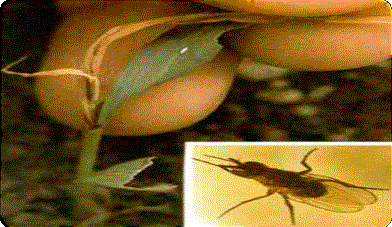
Management:
Shoot fly infestation can be avoided by early sowing to avoid the active period of shoot fly population. If the sowings are completed within 7-10 days of the onset of the monsoon rains, the crop can escape from shoot fly infestation. In the rabi season, sowing between September end to October first week relatively reduces the shoot fly infestation. If early sowing could not be carried out, then use high seed rate. While thinning the crop, remove the seedlings with dead hearts and keep the optimum plant stand in the field.
- Early sowing – Low incidence.
- Late sowing - High incidence
- Remove dead hearts
- High seed rate 8 – 12 kg/ha
- Seed treatment 60 % carbofuran 50% SP (100 gm/kg)
- Application of carbofuran 3 G, Phorate 10 G
- Disulfoton 5G @ 2g/m.row
- Spraying Carbaryl 0.2%,Dimethoate 0.03%
- Tall variety with yellow glossy stem less attacked.
- Use resistant variety IS-2205,IS- 3962,I-5469,IS-1054,s-386,SPV-102
2. Stem borer: Chilo partyellus Swinehoe
Damage:
Subsequently, the larvae bore into the stem resulting in extensive tunneling. The larvae also attack ear heads. Tunneling of ear heads results either in its breakage, or complete or partial chaffy ear heads affecting grain development.
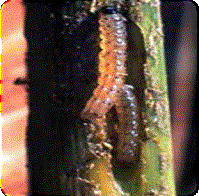
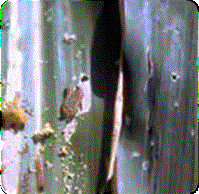
Management:
The stem borer survives during the off-season through the stubbles left in the field after harvest as well as in the stems kept for use as fodder. So, uprooting and burning of the stubbles and chopping of stems prevent its carry over to the next season. Select and grow varieties resistant to spotted stem borer. P-37,IS- 1054,BP-53,IS-2205,SPV-102.
- Spray Endosulfan 0.07 %,Carbryl 0.2 % after 1,1.5 and 2 months after sowing.
OR
- Whorl application of endosulfan 4G or Carbofuran 3G after 20,30,40 DAG @ 8 – 12 Kg/ha.
- Larval parasite Apentelis flavipes and egg parasite Trichogramma is effective.
3. Aphids: Rhopalosiphum maidis Fitch
Damage:
Females give birth to living young without mating and a generation can be completed in about a week. The insect is active throughout the winter. These aphids generally infest the whorl of sorghum plants. Their densities often decline as plants enter the boot and heading stage. Panicles may become heavily infested with corn leaf aphids while the grain is immature. Aphids also secrete a sugary solution called honeydew. A black fungus called sooty mold can grow on the honeydew. The fungus does not directly harm the plant but blocks sunlight from contaminated leaves and can discolor developing seeds. Large infestations can stunt and kill leaves and whole plants.
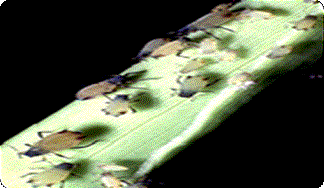
Management :
- Dimethoate 0.03%,neem seed kernal suspension 0.04%+soap.
- Usually natural enemies such as lady beetles,Chrysopa, hover fly larvae, parasitic wasps and others will control aphid infestations.
4. Grain/Earhead Midge: Contarinia sorghicola Coq.
Damage:
The sorghum midge is one of the most damaging insects to sorghum. The adult is a tiny, fragile looking, reddish orange fly about 1 /16 inch long. Larvae are colorless at first, but dark orange when fully grown. Larvae developing inside sorghum flowers prevent seed formation, often resulting low grain yields.
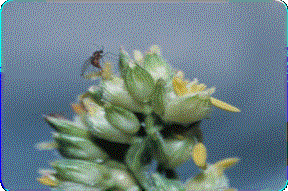
Management:
- Larval parasite Tetrastichus spp. is Effective.
- Predator Anthocord bug,Orius,Ant(Tepinoma indicum)
- Carbaryl 10% dust @20 – 30 kg/ha at 50% flowering & grain formation.
- Malathion 0.05% or Phosalone 0.07% or Endosulphan 0.07%.
- Late sowing has less incidence.
5. Web Worm: Cryptoblabes gnidiella Mill
Damage:
Larva remains near the axis of inflorescens initially scrapping the leaf later on feeds on milky & hard grain. The larva web together adjacent grain with the help of silken threads. The whole ear head is completely webbed with excreta & silken threads
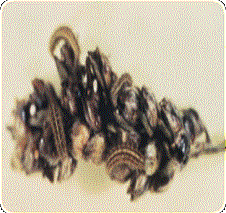
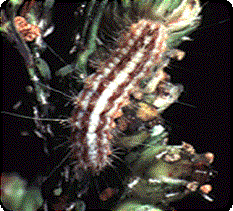
Management:
- Carbaryl 10% ,endosulfan 4% or Malathion 5% dust @ 20 – 25 kg/ha
6. Semi looper: Eublemma silicula Swinhoe
Damage:
Eublemma Larvae fed on maturing grains and concealed themselves under a small dome-shaped or elongated gallery made of anthers and silk. The quality of damaged grains deteriorated when exposed to rain. Populations of larvae of varied from 2 to 6 per earhead. A varietal influence was observed on the incidence. Late August to early September was the most active period for the pest.
Management:
- Collection and destruction of egg masses and hand picking of larvae.
- Summer ploughing and poision baiting.
- Erection of light traps soon after the monsoon for 20-45 days and collecting and killing of adult moths are found very effective.
- Poision baite preparations 10 kg rice bran + 1 kg jaggery +1 liter quinolphos.
- Prepare small balls broad-cost in the fields preferably in the evening times.
Authors:
Manoj Kumar Jat, Dr. Krishna Rolania* and Babu Lal Jat
Department of Entomology, College of Agriculture
CCS, Haryana Agricultural University, Hisar (Haryana)
email:
*Assistant Scientist CCS HAU- Hisar
